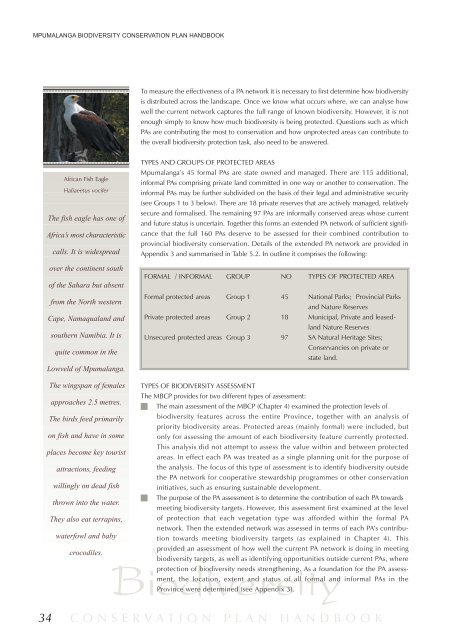Mpumalanga Biodiversity Conservation Plan Handbook - bgis-sanbi
Mpumalanga Biodiversity Conservation Plan Handbook - bgis-sanbi
Mpumalanga Biodiversity Conservation Plan Handbook - bgis-sanbi
Create successful ePaper yourself
Turn your PDF publications into a flip-book with our unique Google optimized e-Paper software.
MPUMALANGA BIODIVERSITY CONSERVATION PLAN HANDBOOK<br />
34<br />
African Fish Eagle<br />
Haliaeetus vocifer<br />
The fish eagle has one of<br />
Africa’s most characteristic<br />
calls. It is widespread<br />
over the continent south<br />
of the Sahara but absent<br />
from the North western<br />
Cape, Namaqualand and<br />
southern Namibia. It is<br />
quite common in the<br />
Lowveld of <strong>Mpumalanga</strong>.<br />
The wingspan of females<br />
approaches 2.5 metres.<br />
The birds feed primarily<br />
on fish and have in some<br />
places become key tourist<br />
attractions, feeding<br />
willingly on dead fish<br />
thrown into the water.<br />
They also eat terrapins,<br />
waterfowl and baby<br />
crocodiles.<br />
To measure the effectiveness of a PA network it is necessary to first determine how biodiversity<br />
is distributed across the landscape. Once we know what occurs where, we can analyse how<br />
well the current network captures the full range of known biodiversity. However, it is not<br />
enough simply to know how much biodiversity is being protected. Questions such as which<br />
PAs are contributing the most to conservation and how unprotected areas can contribute to<br />
the overall biodiversity protection task, also need to be answered.<br />
TYPES AND GROUPS OF PROTECTED AREAS<br />
<strong>Mpumalanga</strong>’s 45 formal PAs are state owned and managed. There are 115 additional,<br />
informal PAs comprising private land committed in one way or another to conservation. The<br />
informal PAs may be further subdivided on the basis of their legal and administrative security<br />
(see Groups 1 to 3 below). There are 18 private reserves that are actively managed, relatively<br />
secure and formalised. The remaining 97 PAs are informally conserved areas whose current<br />
and future status is uncertain. Together this forms an extended PA network of sufficient significance<br />
that the full 160 PAs deserve to be assessed for their combined contribution to<br />
provincial biodiversity conservation. Details of the extended PA network are provided in<br />
Appendix 3 and summarised in Table 5.2. In outline it comprises the following:<br />
FORMAL / INFORMAL GROUP NO TYPES OF PROTECTED AREA<br />
Formal protected areas Group 1 45 National Parks; Provincial Parks<br />
and Nature Reserves<br />
Private protected areas Group 2 18 Municipal, Private and leasedland<br />
Nature Reserves<br />
Unsecured protected areas Group 3 97 SA Natural Heritage Sites;<br />
Conservancies on private or<br />
state land.<br />
TYPES OF BIODIVERSITY ASSESSMENT<br />
The MBCP provides for two different types of assessment:<br />
The main assessment of the MBCP (Chapter 4) examined the protection levels of<br />
biodiversity features across the entire Province, together with an analysis of<br />
priority biodiversity areas. Protected areas (mainly formal) were included, but<br />
only for assessing the amount of each biodiversity feature currently protected.<br />
This analysis did not attempt to assess the value within and between protected<br />
areas. In effect each PA was treated as a single planning unit for the purpose of<br />
the analysis. The focus of this type of assessment is to identify biodiversity outside<br />
the PA network for cooperative stewardship programmes or other conservation<br />
initiatives, such as ensuring sustainable development.<br />
The purpose of the PA assessment is to determine the contribution of each PA towards<br />
meeting biodiversity targets. However, this assessment first examined at the level<br />
of protection that each vegetation type was afforded within the formal PA<br />
network. Then the extended network was assessed in terms of each PA’s contribution<br />
towards meeting biodiversity targets (as explained in Chapter 4). This<br />
M P U M A L A N G A<br />
provided an assessment of how well the current PA network is doing in meeting<br />
<strong>Biodiversity</strong><br />
biodiversity targets, as well as identifying opportunities outside current PAs, where<br />
protection of biodiversity needs strengthening. As a foundation for the PA assessment,<br />
the location, extent and status of all formal and informal PAs in the<br />
Province were determined (see Appendix 3).<br />
CONSERVATION PLAN HANDBOOK

















